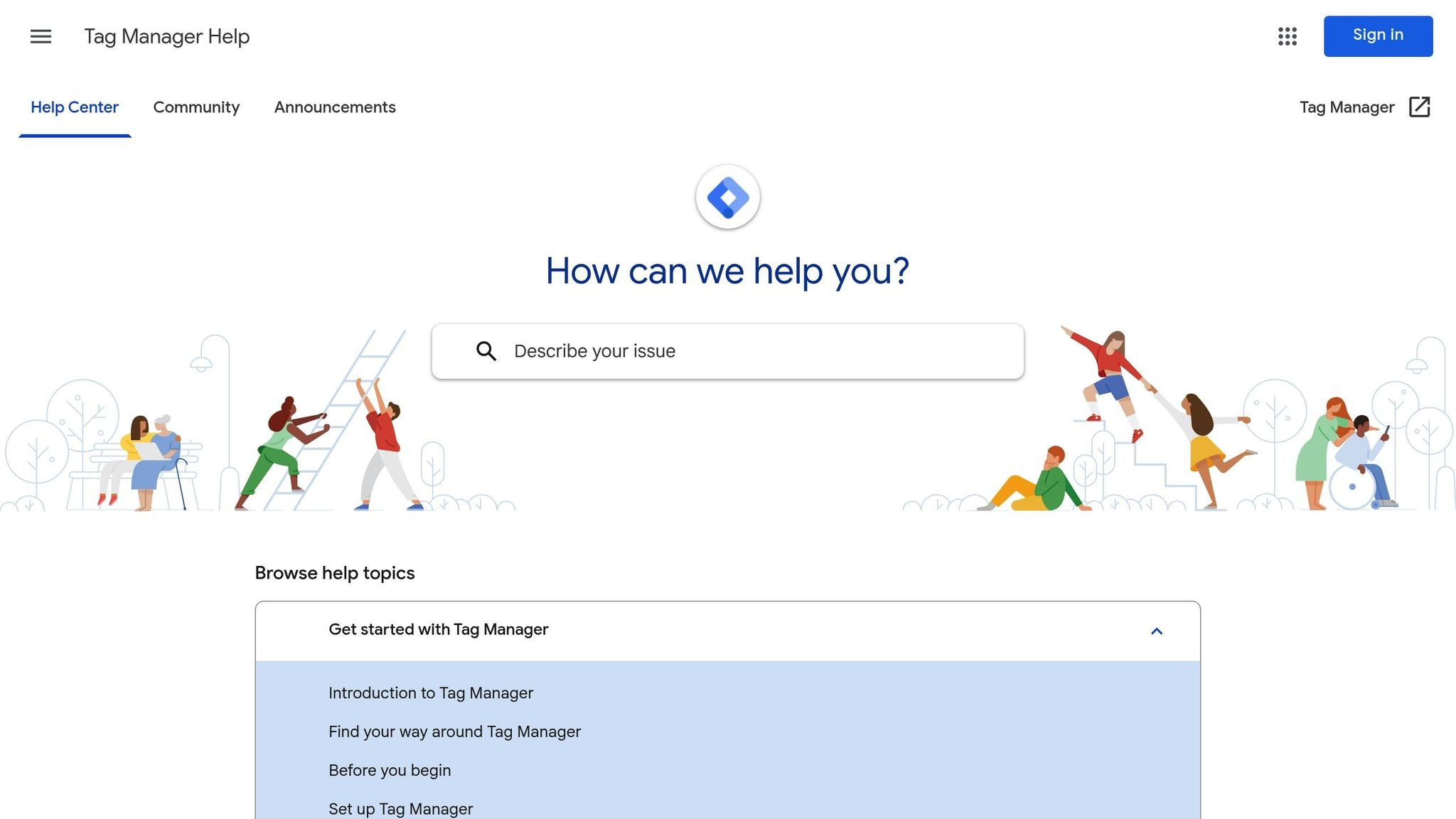Custom event parameters in GA4 let you track specific business data beyond standard metrics. They help you analyze user behavior, enhance reporting, and improve marketing strategies. Here's what you need to know:
- What They Are: Extra details added to events, like product colors, sizes, or shipping methods.
- Why Use Them: Gain deeper insights, track unique metrics, and create precise audience segments.
- How to Use Them: Follow naming rules (e.g., lowercase, no spaces), stay within GA4 limits (50 custom dimensions, 25 parameters per event), and test thoroughly.
- Setup Steps: Use Google Tag Manager, create custom dimensions in GA4, and ensure consistency across platforms.
- Maintenance Tips: Audit quarterly, keep names consistent, and remove outdated parameters.
How to Set Up Custom GA4 Event Parameters as Dimensions ...
Setting Up Custom Event Parameters
Custom event parameters require careful planning and adherence to specific guidelines to ensure accurate data collection.
Parameter Naming Rules
Using clear and descriptive parameter names helps keep your data organized. Stick to these naming conventions:
- Use lowercase letters and underscores (e.g.,
product_color,shipping_method). - Keep names short but meaningful.
- Avoid spaces or special characters.
- Maintain consistent naming patterns for related parameters.
- Limit names to 40 characters.
Here’s an example of how to structure your parameter names when tracking product attributes:
| Parameter Purpose | Good Name | Poor Name |
|---|---|---|
| Product Category | prod_category | category1 |
| Shipping Option | shipping_method | ship_opt |
| Payment Type | payment_type | paymt |
| Loyalty Level | loyalty_tier | tier |
Once your naming conventions are in place, ensure your setup aligns with the limits imposed by GA4.
Working Within GA4 Limits
GA4 has specific restrictions that require thoughtful parameter management:
- Custom Dimension Limit: 50 per property
- Event Parameter Limit: 25 per event
- Parameter Value Length: 100 characters maximum
Focus on parameters that directly impact metrics like conversions or revenue before adding less critical ones.
Cross-Stream Parameter Setup
To ensure consistency across all data streams, follow these steps:
-
Create a Parameter Registry
Document parameter names, descriptions, expected values, formats, and implementation guidelines. Include examples of how they should be used. -
Implement Version Control
Keep track of modifications by documenting the dates of changes, noting when parameters are deprecated, and recording new additions. Maintain a changelog for reference. -
Establish Quality Controls
Conduct regular audits, check value formats, verify consistency across platforms, and use automated testing scripts to catch errors.
Setup Steps and Methods
Here's how to configure and test custom event parameters in GA4 using Google Tag Manager (GTM):
Using Google Tag Manager

- Open your GTM container and create a new GA4 Event Tag. Add your measurement ID and specify the event name.
- Include custom parameters based on your setup needs.
- Define triggers to fire the tag when specific user interactions occur.
| Trigger Type | Use Case | Example Configuration |
|---|---|---|
| Page View | Track page-specific data | Trigger when the URL includes "/product/" |
| Click | Capture interaction data | Click element contains "add-to-cart" |
| Form Submit | Record form submissions | Form ID equals "checkout-form" |
Creating Custom Dimensions
- Go to Admin > Custom Definitions in GA4.
- Click Create Custom Dimensions and select the event parameter you want to use.
- Choose the scope (event or user) that fits your goal.
Testing and Verification
-
GTM Preview Mode and GA4 DebugView
- Check that tags fire correctly and the data layer is populated as expected.
- Confirm that events display with properly formatted parameter values.
-
Build a Test Report
- Verify that data appears in the correct format.
- Ensure parameters aggregate as intended.
- Confirm dimension values align with the source data.
Thorough testing is essential to ensure accurate tracking and reporting.
sbb-itb-5174ba0
Report Setup and Management
Event Name Management
Organize your event tracking by grouping events into broad categories and using parameters to capture specific details.
| Event Category | Base Event Name | Parameter Examples |
|---|---|---|
| Purchases | purchase_complete | product_category, payment_method, order_value |
| Downloads | file_download | file_type, file_name, file_size |
| Form Submissions | form_submit | form_name, form_page, submission_status |
Regularly review and update event names to ensure they align with your current tracking goals.
Parameter Maintenance
To keep your data clean and effective, follow a quarterly review process:
- Audit usage: Check which parameters are actively used and remove any that are outdated or unnecessary. Remember, GA4 allows a maximum of 50 parameters per event.
- Update documentation: Maintain a central record that explains each parameter's purpose, format, and acceptable values.
- Validate data quality: Look for inconsistencies in parameter values or formatting across different data sources and correct them.
Data Format Standards
Use standardized formatting for parameters to ensure accurate and consistent reporting:
Numeric Values
- Use decimals for numbers (e.g., 99.99) without commas or currency symbols.
Text Values
- Stick to lowercase text (e.g., "premium_plan" instead of "Premium_Plan").
- Replace spaces with underscores (e.g., "shopping_cart" instead of "shopping cart").
- Keep values under 100 characters to avoid truncation.
Boolean Values
- Use
true/falserather than alternatives likeyes/noor1/0. Always use lowercase for consistency (e.g., "true" instead of "True").
| Value Type | Correct Format | Incorrect Format |
|---|---|---|
| Currency | 1299.99 | $1,299.99 |
| Product ID | prod_12345 | Product-12345 |
| Category | mens_shoes | Men's Shoes |
| Status | true | YES |
Standard vs Custom Parameters
When setting up GA4 tracking, it's important to understand the difference between standard and custom parameters. Standard parameters are built into GA4 and automatically collected, while custom parameters let you track data tailored to your business needs.
| Parameter Type | Characteristics | Limitations | Best Use Cases |
|---|---|---|---|
| Standard | Pre-defined by GA4, automatically collected | Fixed format, cannot be changed | Tracking basic user interactions, page views, and sessions |
| Custom | User-defined with flexible naming options | Subject to GA4 limits | Tracking product details, transaction data, and user preferences |
Standard Parameters
Standard parameters handle essential tracking without any setup. These include:
page_title: Captures the title of the webpagepage_location: Records the full URLscreen_resolution: Tracks the device's display settingslanguage: Identifies the user's preferred language
Custom Parameters
Custom parameters are perfect for tracking business-specific data. For example, an online store might use:
product_variant: To track different versions of a productshipping_method: To monitor delivery preferencesloyalty_tier: To record customer membership levels
Key Guidelines for Custom Parameters
- Non-numeric values are treated as strings.
- Numeric values must be entered as plain numbers.
- Custom parameters must follow GA4's formatting rules and limits.
Additional Considerations
Parameter Scope
Standard parameters are consistent across all GA4 properties, making them ideal for cross-property analysis. Custom parameters, on the other hand, require proper documentation and internal standardization to ensure data accuracy.
Processing Efficiency
Standard parameters are processed automatically by GA4, while custom parameters might need extra configuration.
Storage and Reporting
Standard parameters show up in default reports, but custom parameters must be manually added to custom reports or explorations.
Summary and Action Items
Custom event parameters in GA4 require careful setup and consistent monitoring. Use the following steps to strengthen your GA4 parameter approach:
Parameter Setup Checklist
- Perform an initial audit to spot any tracking gaps.
- Create and document clear naming conventions.
- Test parameters in a development environment before launch.
- Confirm data collection in a test environment.
- Plan quarterly reviews to keep parameters updated.
Best Practices for Implementation
- Use short, descriptive names (under 40 characters).
- Stick to lowercase letters and underscores for uniformity.
- Document each parameter's purpose and expected values.
- Keep within GA4's 50 custom dimensions limit per property.
- Remove parameters that are no longer in use to maintain efficiency.
Integration with Analytics Tools
Leverage the Marketing Analytics Tools Directory to discover tools for:
- A/B testing
- Customer Data Platforms (CDPs)
- Data visualization
- Data validation
Parameter Maintenance Schedule
Follow this schedule to ensure data quality remains high over time:
| Timeframe | Action Items |
|---|---|
| Weekly | Check the accuracy of parameter data collection. |
| Monthly | Review parameter usage and delete inactive ones. |
| Quarterly | Audit naming conventions and update documentation. |
| Annually | Ensure parameters align with current business goals. |
FAQs
How do custom event parameters in GA4 enhance my marketing strategy?
Custom event parameters in Google Analytics 4 (GA4) allow you to track specific user behaviors and interactions that are most relevant to your business goals. By defining these parameters, you can collect detailed data tailored to your campaigns, products, or services.
This level of customization helps you uncover actionable insights, such as identifying high-performing audience segments, optimizing ad spend, and improving user engagement. When implemented effectively, custom event parameters enable more precise tracking, better reporting, and ultimately, smarter data-driven decisions for your marketing strategy.
What mistakes should I avoid when setting up custom event parameters in GA4?
When setting up custom event parameters in Google Analytics 4 (GA4), there are a few common mistakes to watch out for:
- Using too many parameters: Adding excessive custom parameters can make your data harder to analyze and may exceed GA4's limits. Focus on only the most relevant ones.
- Inconsistent naming conventions: Avoid using inconsistent or unclear parameter names. Stick to a clear, standardized naming system for easy tracking and analysis.
- Skipping validation: Always test your custom event parameters to ensure they are firing correctly and collecting the intended data.
By avoiding these pitfalls, you can ensure your custom event parameters are effective and aligned with your analytics goals.
How can I maintain consistency in custom event parameters across multiple data streams in GA4?
To ensure consistency in custom event parameters across different data streams in Google Analytics 4 (GA4), follow these key practices:
- Standardize naming conventions: Use clear, descriptive, and consistent names for your custom event parameters. Avoid special characters and stick to lowercase to prevent discrepancies.
- Create a parameter dictionary: Maintain a shared document or reference guide that lists all custom parameters, their definitions, and usage examples. This ensures all team members are aligned.
- Test before implementation: Use GA4's DebugView to verify that custom parameters are being captured correctly across all data streams before rolling them out.
By implementing these strategies, you can reduce errors and make your GA4 data more reliable and actionable for analysis.


